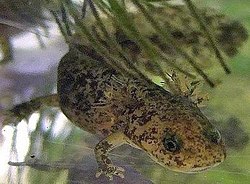| Hida salamander | |
|---|---|
 | |
 | |
| Scientific classification | |
| Kingdom: | Animalia |
| Phylum: | Chordata |
| Class: | Amphibia |
| Order: | Urodela |
| Family: | Hynobiidae |
| Genus: | Hynobius |
| Species: | H. kimurae |
| Binomial name | |
| Hynobius kimurae Dunn, 1923 | |
| Synonyms [2] | |
| |
The Hida salamander or Hondo salamander (Hynobius kimurae) is a species of salamander in the family Hynobiidae, the Asiatic salamanders. It is endemic to central and western Honshu, Japan. [2] It lives in deciduous, coniferous, and mixed forests, where it breeds in streams. [1] The egg sacs of this species were reported to display blue-to-yellow iridescent glow due to a quasi-periodic diffraction grating structure embedded within the enveloppes of the egg sacs. [3] These salamanders typically spawn from February to April, leading some to metamorphose in late September while others wait for the following year to do so after winter is over. [4]
